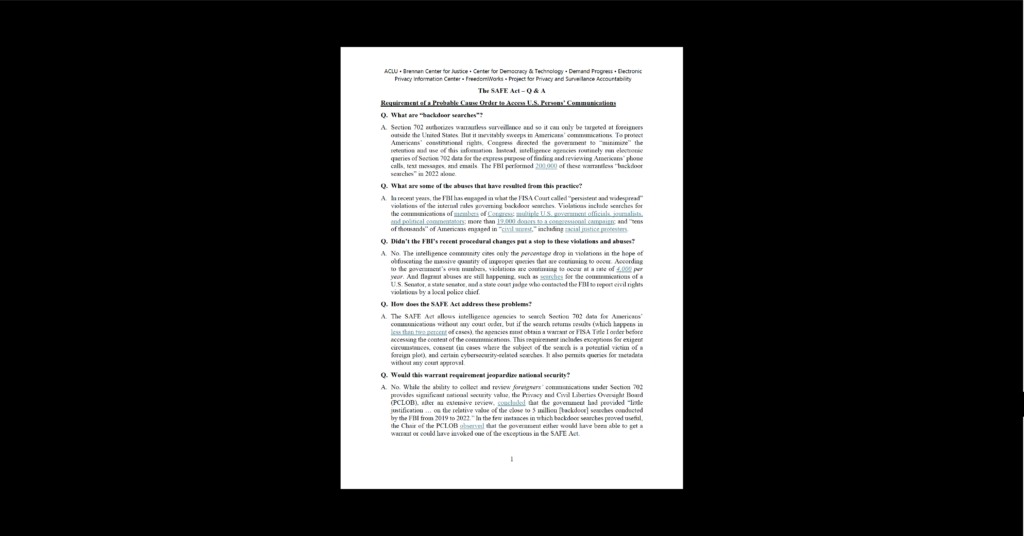Government Surveillance, Privacy & Data
Jones, Drones, and (GPS Tracked) Automobiles

With February’s FAA reauthorization placing drones on an accelerated path to domestic use, Congress and the courts need to take action to place appropriate restrictions on drone activities in American airspace. Failure to do so will allow yet another privacy invasive technology to outstrip legal and regulatory boundaries, putting American’s civil liberties at risk for decades to come.
The prospect of government surveillance drones hovering over cities across the country is troubling for several reasons. The Supreme Court ruled in U.S. v. Jones that law enforcement needs a warrant before physically attaching a GPS device to a vehicleSpecifically, the Court ruled that attachment of a GPS device to a car constituted a trespass, and was therefore impermissible absent a warrant. United States v. Jones, 132 S. Ct. 945, 950 (2012). ; however, drones pull an end run on Jones by giving law enforcement the same means to continuously track individuals without the need to attach a device.
Drones can also provide continuous and general surveillance of the public, which increases the angst about the loss of privacy. Throw government use of facial recognition technology into the mix and it’s no surprise that 64% of Americans say they are somewhat or very concerned about law enforcement’s use of drones.
Several avenues are available to ensure drone use is appropriately limited. First, the courts should apply Fourth Amendment protections to this form of public surveillance. Many contend there is strong legal basis for this in the concurring opinions of Justices Alito and Sotomayor in Jones.Justice Sotoymayor stated in her concurring opinion, “I would also consider the appropriateness of entrusting to the Executive, in the absence of any oversight from a coordinate branch, a tool [referring to a GPS surveillance device] so amenable to misuse, especially in light of the Fourth Amendment’s goal to curb arbitrary exercises of police power to and prevent ‘a too permeating police surveillance.’” United States v. Jones, 132 S. Ct. 945, 956 (2012) (Sotomayor, J., concurring). At the Privacy Law Scholars Conference on June 8, some of the nation’s foremost academics shared their ideas about how to apply the reasoning in the Jones concurrences to intrusive, persistent surveillance in the public sphere, such as with drone surveillance. Whether the Court will apply the Fourth Amendment to drone surveillance will be seen as such cases begin to arise.
Another method of regulating drone use is legislation. Recently, Representative Austin Scott (R-GA) and Senator Rand Paul (R-KY) proposed companion bills, H.R. 5925 and S. 3287, that would require law enforcement to obtain a warrant when using a drone to “gather evidence or other information pertaining to criminal conduct.” Both bills include exceptions permitting drone use without a warrant for border security, in exigent circumstances involving imminent danger, and when DHS determines that there is a high risk of a terrorist attack.
The House bill’s exigent circumstances exception is broader, and unlike the Senate bill, extends to imminent danger to property (not just to a person), fleeing suspects and destruction of evidence. This seems wise. Both bills prohibit generalized surveillance, preventing law enforcement from using drones for untargeted surveillance to look for the possibility of crime. Yet, both bills anticipate weaponized drones that can deliver a lethal payload — a military tactic that would be unwise to import from the wars in Afghanistan and Iraq. An amendment by Rep. Michael Burgess (R-TX) to the Transportation Appropriations bill prohibiting the use or sale of weaponized drones in the U.S. failed on procedural grounds.
While the Paul and Scott bills set a good foundation for regulating drone-based surveillance, a more complete policy on drone use, which we’ve previously written about, would also require enhanced transparency and accountability measures.
Private use of drones should also be regulated for privacy reasons. Those protections should be based on the Fair Information Practice Principles adopted through an open federal rulemaking process.
Whether the courts or Congress tackle this issue, it is imperative that any approach not only to addresses current concerns, but also contemplates changes in technology. For example, Jones – which stemmed from GPS tracking of a vehicle in 2005 – would today likely see law enforcement using cell site location tracking rather than GPS.
Technology traditionally outpaces the law but we have a chance to keep that from happening in the nascent field of drone use. Regulating drone use is a good step forward, but we will continue to face new threats to privacy until we develop comprehensive privacy protections that take on the issues of tomorrow as well as today.


